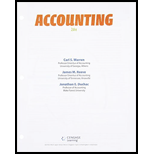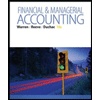
1.
Bonds: Bonds are long-term promissory notes that are represented by a company while borrowing money from investors to raise fund for financing the operations.
Bonds Payable: Bonds payable are referred to long-term debts of the business, issued to various lenders known as bondholders, generally in multiples of $1,000 per bond, to raise fund for financing the operations.
Premium on bonds payable: It occurs when the bonds are issued at a high price than the face value.
Effective-interest amortization method: Effective-interest amortization method it is an amortization model that apportions the amount of bond discount or premium based on the market interest rate.
To Prepare:
2 (a)
To Prepare: Journal entry to record first semiannual interest payment and amortization of bond premium on December 31, 2016.
2 (b)
To Prepare: Journal entry to record second interest payment and amortization of bond discount on June 30, 2017.
3.
The amount of total interest expense for 2016.
Want to see the full answer?
Check out a sample textbook solution
Chapter 14 Solutions
Bundle: Accounting, Loose-Leaf Version, 26th + CengageNOWv2, 2 term Printed Access Card
- On January 3, 2020, Salma Industries acquired equipment for $420,000. The estimated useful life of the equipment is 6 years or 100,000 machine hours, with a residual value of $30,000. What is the book value of the asset on December 31, 2021, if Salma Industries uses the straight-line method of depreciation?arrow_forwardWillow & Sons Ltd. has $312,000 in accounts receivable on February 1. Budgeted sales for February are $820,000. Willow & Sons expects to sell 25% of its merchandise for cash. Of the remaining 75% of sales on account, 60% are expected to be collected in the month of sale and the remainder the following month. What are the February cash collections from sales? Provide answerarrow_forwardCrescent Corp. sells merchandise to Primex Ltd. for $9,800 with credit terms of 2/10, net 30. Primex returns $1,500 worth of merchandise due to defects and sends a check within the discount period. What is the amount of the check?arrow_forward
 Cornerstones of Financial AccountingAccountingISBN:9781337690881Author:Jay Rich, Jeff JonesPublisher:Cengage LearningPrinciples of Accounting Volume 1AccountingISBN:9781947172685Author:OpenStaxPublisher:OpenStax College
Cornerstones of Financial AccountingAccountingISBN:9781337690881Author:Jay Rich, Jeff JonesPublisher:Cengage LearningPrinciples of Accounting Volume 1AccountingISBN:9781947172685Author:OpenStaxPublisher:OpenStax College Financial Accounting: The Impact on Decision Make...AccountingISBN:9781305654174Author:Gary A. Porter, Curtis L. NortonPublisher:Cengage Learning
Financial Accounting: The Impact on Decision Make...AccountingISBN:9781305654174Author:Gary A. Porter, Curtis L. NortonPublisher:Cengage Learning Financial & Managerial AccountingAccountingISBN:9781285866307Author:Carl Warren, James M. Reeve, Jonathan DuchacPublisher:Cengage Learning
Financial & Managerial AccountingAccountingISBN:9781285866307Author:Carl Warren, James M. Reeve, Jonathan DuchacPublisher:Cengage Learning Intermediate Accounting: Reporting And AnalysisAccountingISBN:9781337788281Author:James M. Wahlen, Jefferson P. Jones, Donald PagachPublisher:Cengage Learning
Intermediate Accounting: Reporting And AnalysisAccountingISBN:9781337788281Author:James M. Wahlen, Jefferson P. Jones, Donald PagachPublisher:Cengage Learning Financial AccountingAccountingISBN:9781305088436Author:Carl Warren, Jim Reeve, Jonathan DuchacPublisher:Cengage Learning
Financial AccountingAccountingISBN:9781305088436Author:Carl Warren, Jim Reeve, Jonathan DuchacPublisher:Cengage Learning





